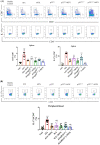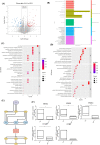Mutant p53R211* ameliorates inflammatory arthritis in AIA rats via inhibition of TBK1-IRF3 innate immune response
- PMID: 37935918
- PMCID: PMC10656327
- DOI: 10.1007/s00011-023-01809-w
Mutant p53R211* ameliorates inflammatory arthritis in AIA rats via inhibition of TBK1-IRF3 innate immune response
Abstract
Background: Rheumatoid arthritis (RA) is an autoimmune inflammation disease characterized by imbalance of immune homeostasis. p53 mutants are commonly described as the guardian of cancer cells by conferring them drug-resistance and immune evasion. Importantly, p53 mutations have also been identified in RA patients, and this prompts the investigation of its role in RA pathogenesis.
Methods: The cytotoxicity of disease-modifying anti-rheumatic drugs (DMARDs) against p53 wild-type (WT)/mutant-transfected RA fibroblast-like synoviocytes (RAFLSs) was evaluated by MTT assay. Adeno-associated virus (AAV) was employed to establish p53 WT/R211* adjuvant-induced arthritis (AIA) rat model. The arthritic condition of rats was assessed by various parameters such as micro-CT analysis. Knee joint samples were isolated for total RNA sequencing analysis. The expressions of cytokines and immune-related genes were examined by qPCR, ELISA assay and immunofluorescence. The mechanistic pathway was determined by immunoprecipitation and Western blotting in vitro and in vivo.
Results: Among p53 mutants, p53R213* exhibited remarkable DMARD-resistance in RAFLSs. However, AAV-induced p53R211* overexpression ameliorated inflammatory arthritis in AIA rats without Methotrexate (MTX)-resistance, and our results discovered the immunomodulatory effect of p53R211* via suppression of T-cell activation and T helper 17 cell (Th17) infiltration in rat joint, and finally downregulated expressions of pro-inflammatory cytokines. Total RNA sequencing analysis identified the correlation of p53R211* with immune-related pathways. Further mechanistic studies revealed that p53R213*/R211* instead of wild-type p53 interacted with TANK-binding kinase 1 (TBK1) and suppressed the innate immune TBK1-Interferon regulatory factor 3 (IRF3)-Stimulator of interferon genes (STING) cascade.
Conclusions: This study unravels the role of p53R213* mutant in RA pathogenesis, and identifies TBK1 as a potential anti-inflammatory target.
Keywords: IRF3; Rheumatoid arthritis; STING; TBK1; p53 mutant.
© 2023. The Author(s).
Conflict of interest statement
The authors declare no conflict of interest.
Figures







Similar articles
-
Synoviocyte innate immune responses: TANK-binding kinase-1 as a potential therapeutic target in rheumatoid arthritis.Rheumatology (Oxford). 2012 Apr;51(4):610-8. doi: 10.1093/rheumatology/ker154. Epub 2011 May 25. Rheumatology (Oxford). 2012. PMID: 21613249 Free PMC article.
-
Trikatu, an herbal compound ameliorates rheumatoid arthritis by the suppression of inflammatory immune responses in rats with adjuvant-induced arthritis and on cultured fibroblast like synoviocytes via the inhibition of the NFκB signaling pathway.Chem Biol Interact. 2016 Oct 25;258:175-86. doi: 10.1016/j.cbi.2016.09.003. Epub 2016 Sep 6. Chem Biol Interact. 2016. PMID: 27613480
-
Therapeutic effects of shikonin on adjuvant-induced arthritis in rats and cellular inflammation, migration and invasion of rheumatoid fibroblast-like synoviocytes via blocking the activation of Wnt/β-catenin pathway.Phytomedicine. 2023 Jul 25;116:154857. doi: 10.1016/j.phymed.2023.154857. Epub 2023 May 3. Phytomedicine. 2023. PMID: 37163904
-
The p53 status in rheumatoid arthritis with focus on fibroblast-like synoviocytes.Immunol Res. 2021 Jun;69(3):225-238. doi: 10.1007/s12026-021-09202-7. Epub 2021 May 13. Immunol Res. 2021. PMID: 33983569 Review.
-
TANK-Binding Kinase 1 in the Pathogenesis and Treatment of Inflammation-Related Diseases.Int J Mol Sci. 2025 Feb 24;26(5):1941. doi: 10.3390/ijms26051941. Int J Mol Sci. 2025. PMID: 40076567 Free PMC article. Review.
Cited by
-
The role of cGAS-STING signaling in rheumatoid arthritis: from pathogenesis to therapeutic targets.Front Immunol. 2024 Sep 25;15:1466023. doi: 10.3389/fimmu.2024.1466023. eCollection 2024. Front Immunol. 2024. PMID: 39386207 Free PMC article. Review.
-
IRF3 Promotes Production of IL-6 and Nitric Oxide but Represses CCL22 in RAW264.7 Macrophage Cells Exposed to Lipopolysaccharides in Culture.J Inflamm Res. 2025 Jan 27;18:1255-1265. doi: 10.2147/JIR.S496930. eCollection 2025. J Inflamm Res. 2025. PMID: 39897523 Free PMC article.
-
cGAS-STING pathway in pathogenesis and treatment of osteoarthritis and rheumatoid arthritis.Front Immunol. 2024 May 3;15:1384372. doi: 10.3389/fimmu.2024.1384372. eCollection 2024. Front Immunol. 2024. PMID: 38765007 Free PMC article. Review.
References
-
- Komatsu N, Takayanagi H. Mechanisms of joint destruction in rheumatoid arthritis—immune cell–fibroblast–bone interactions. Nat Rev Rheumatol. 2022;18:415–429. - PubMed
-
- Takayanagi H. Osteoimmunology: shared mechanisms and crosstalk between the immune and bone systems. Nat Rev Immunol. 2007;7:292–304. - PubMed
-
- Firestein GS. Immunologic mechanisms in the pathogenesis of rheumatoid arthritis. JCR J Clin Rheumatol. 2005;11:S39–S44. - PubMed
-
- Wong VKW. Editorial overview: new technologies in 2020: drug resistance. Curr Opin Pharm. 2020;54:iii–vi. - PubMed
MeSH terms
Substances
Grants and funding
LinkOut - more resources
Full Text Sources
Medical
Molecular Biology Databases
Research Materials
Miscellaneous

